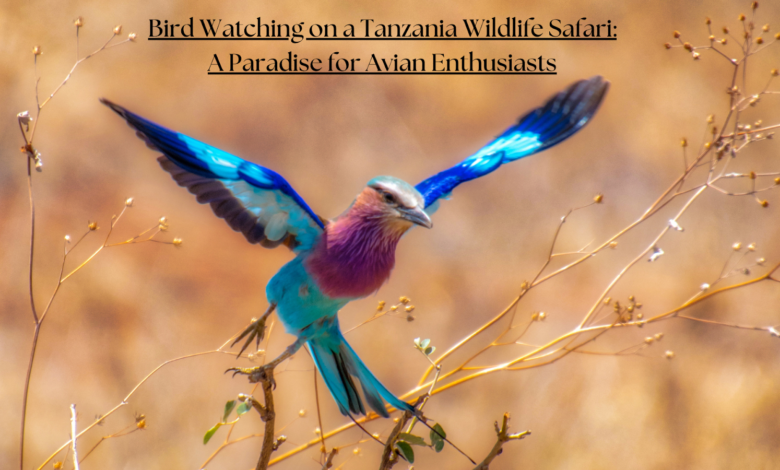Bird Watching on a Tanzania Wildlife Safari: A Paradise for Avian Enthusiasts

Tanzania, a haven for bird watchers, boasts an impressive roster of over 1,100 bird species. This diversity includes a fascinating mix of endemic and migratory birds, attracting enthusiasts from around the globe.
Whether you’re a seasoned birder or a curious traveler, Tanzania’s vibrant bird life offers a spectacular display against the backdrop of its renowned wild landscapes.
In this blog, we will explore the top bird watching destinations across Tanzania, discuss the best times to visit for optimal birding, and suggest practical tips to enhance your bird watching journey.
Top Destinations for Bird Watching in Tanzania
Exploring Tanzania for bird watching offers a collection of environments, each with unique species and ecological features. Join us as we explore the world of Tanzania’s feathered inhabitants, where every call and color tells a story of survival and splendor. For those looking to explore these natural spectacles, Tanzania safari packages offer customized itineraries that cover these peak birding months, ensuring you get the most out of your wildlife safari experience.
Here’s a clear look at each destination to help you plan your birding adventure:
Serengeti National Park
Known as one of the most iconic landscapes in Africa, the Serengeti is synonymous with wildlife and breathtaking scenery. For bird enthusiasts, it’s a paradise with over 500 species of birds to explore. Key spots include the Grumeti River, where the African Fish Eagle dominates the skies, and the central Seronera region, a haven for the secretive leopard and a variety of birds like the Kori Bustard and Secretary Bird.
Ngorongoro Crater
The Ngorongoro Conservation Area, which includes the crater and vast highlands, is home to approximately 500 bird species. This natural amphitheater creates an isolated environment where birds flourish close to a dense concentration of African wildlife. The soda lake within the crater is especially popular for flamingos and pelicans, while the forests around the rim are frequented by turacos and hornbills.
Lake Manyara National Park
Lake Manyara is a bird watcher’s dream with its legendary tree-climbing lions and incredible biodiversity. The alkaline lake draws thousands of flamingos to its shores. The groundwater forest near the gate provides lush scenery and a chance to spot the Silvery-cheeked Hornbill and the Crowned Eagle. The acacia woodland areas are teeming with the Calls of the Crested Francolin and the distinct tapping of woodpeckers.
Tarangire National Park
Famous for its elephants and baobabs, Tarangire is also rich in avifauna, especially during the dry season when the area attracts the highest number of breeding species. The park’s swamps are alive with various heron species, the Openbill Stork, and large flocks of mixed wader birds.
Rufiji Delta
Located in the Selous Game Reserve, the Rufiji River Delta is a critical habitat for waterbirds and a key site for bird conservation. The delta’s mangroves and freshwater lagoons support species not easily seen elsewhere in Tanzania such as the Mangrove Kingfisher and the rare Pel’s Fishing Owl.
Eastern Arc Mountains
This chain of ancient, forest-covered mountains running through Tanzania is recognized globally for its biodiversity and high number of endemic species. The Usambara and Udzungwa Mountains, part of this range, offer spectacular bird watching opportunities.
Species such as the Usambara Weaver, Udzungwa Partridge, and Loveridge’s Sunbird are some of the highlights. These mountains provide not only a refuge for these unique species but also breathtaking hiking and excellent birding opportunities for adventurous travelers.
Each of these destinations in Tanzania offers unique experiences and spectacular bird sightings that cater to both novice birders and experienced ornithologists. Planning your visit during the right season will increase your chances of observing a wide area of birdlife in its most active and vibrant state.
Best Time for Bird Watching in Tanzania
Timing your bird watching safari in Tanzania is crucial for maximizing your experience. The country’s varied climates and ecological zones mean that bird activity fluctuates throughout the year. Here’s a breakdown of the best times to visit for optimal bird watching:
Peak Birding Season (November to April)
The period from November to April is considered the prime time for bird watching in Tanzania. This season coincides with the rainy season when many birds are in their breeding plumage, which is often more vibrant and makes them easier to spot. Also, this is the time when migratory birds from Europe and Northern Africa flock to Tanzania, significantly increasing the diversity of species available for observation.
- Migratory Birds: During these months, Tanzania becomes a temporary home for migratory species escaping the cold northern winters. Lakes and wetlands teem with life as European and North African birds join the local populations.
- Breeding Season: Many resident birds are also in their breeding season during this time, engaging in nesting activities and displaying breeding behaviors and plumage that are a delight to observe. This includes elaborate mating dances, vocal performances, and vibrant feather displays.
Dry Season (May to October)
While the peak season offers the greatest diversity, the dry season provides its advantages for bird watchers:
- Visibility: With less vegetation and fewer water sources, birds tend to congregate around available waterholes and lakes, making them easier to spot and observe.
- Less Rain: The drier weather means fewer interruptions from rain during your excursions, and the reduced mosquito activity during this time can make for a more comfortable bird watching experience.
- Special Sightings: A few species such as the resident flamingos, have different patterns and may be more visible during the dry months when their primary food sources are concentrated in the remaining waters.
Regional Considerations
Different areas of Tanzania have their own best times for bird watching based on specific ecological patterns:
- Northern Tanzania (Serengeti, Ngorongoro, Tarangire): Ideal in the early months of the year when the rains bring fresh life to the savannah and woodland areas, attracting a plethora of bird species.
- Southern and Western Tanzania (Selous, Ruaha, Katavi): Here, bird life is prolific during the dry season when birds are drawn to the remaining water sources.
Event-Driven Birding
For those interested in specific events in the birding calendar such as the arrival of migratory raptors or witnessing the breeding of endemic species, planning around these events regardless of the general best time can provide exceptional bird watching opportunities.
In conclusion, while November to April offers the most vibrant and diverse bird watching experience in Tanzania, visiting during the dry season can also provide unique sightings with easier spotting conditions. Understanding the specific characteristics of each season and how they align with your bird watching goals will ensure a rewarding safari experience.
Conservation Efforts
Tanzania is actively engaged in conservation efforts to protect critical habitats for both resident and migratory birds, with 80 Important Birding Areas (IBAs) covering about 18% of the country. These efforts help preserve the region’s biodiversity and also ensure the safety of wildlife and human visitors by promoting coexistence and respect for natural habitats.
Bird Watching Tips
- Hiring Guides: Local guides enhance the experience by sharing intricate knowledge of bird habitats and behaviors.
- Essential Gear: Equip yourself with high-quality binoculars, a comprehensive bird guide, and a good camera.
- Patience: The key to bird watching is patience, quietly observing your surroundings will reveal the best sightings.
FAQ
What are some must-see bird species in Tanzania?
Ashy Starling, Fischer’s Lovebird, and Tanzanian Red-billed Hornbill are some of the unique species that make Tanzania a special birding destination.
Can bird watching in Tanzania be combined with other wildlife viewing activities?
Absolutely! Birding can be seamlessly integrated with game drives that offer close encounters with the Big Five and other wildlife, making it a comprehensive safari experience.
What should I bring for a bird watching tour in Tanzania?
Sturdy footwear, a weather-resistant camera with a good zoom, Protective clothing for diverse climates, high-quality binoculars, and a bird field guide are essential.
Conclusion
Bird watching in Tanzania is more than a leisure activity, it’s an exploration of biodiversity that contributes significantly to ecological conservation and offers a deep, rewarding connection with nature. The experience is a profound reminder of our responsibility to protect these environments for future generations.
Ready to undertake a bird watching adventure that you will cherish for a lifetime? Start planning your Tanzania wildlife safari today and prepare to be amazed by the spectacular avian world waiting for you!



